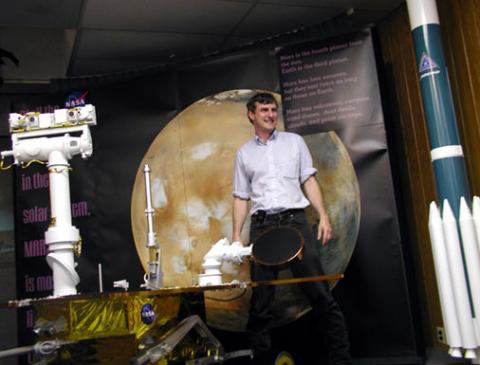event
Roving Mars: Spirit, Opportunity and the Exploration of the Red Planet
Primary tabs
The Center for Space Technology and Research (CSTAR) is honored to present Dr. Steven Squyres, Principal Investigator for the science payload on the Mars Exploration Rover Project and Professor of astronomy at Cornell University, as its invited speaker in the CSTAR Distinguished Lecture Series. This talk will provide an up-to-date summary of the missions of Spirit and Opportunity, from their initial conception through their development, launch, landing, and operations on the surface of Mars.
In January of 2004, twin robotic explorers named Spirit and Opportunity landed on Mars. Expected to last for 90 days, their mission has now gone on for more than eleven years. Its objective is to search for evidence of past water on Mars, and to determine if Mars ever had conditions that would have been suitable for life.
Spirit landed in Gusev Crater, a large impact crater in the southern highlands of Mars. Finding only ancient lava on the crater floor, Spirit drove a mile and a half to the base of the Columbia Hills, a mountain range near the landing site. There Spirit ascended Husband Hill, the highest summit in the range, finding evidence that the rocks were modified long ago by water. Later, Spirit found strong evidence for ancient hot springs on Mars. Spirit’s mission ended after six years on the martian surface.
Opportunity landed on Meridiani Planum, a smooth plateau near the martian equator. In the first few weeks after landing, Opportunity found compelling evidence for long-ago water on Mars. This evidence included thick deposits of sulfate salts, concretions that precipitated from liquid water, and rocks that preserve ancient ripples formed when water flowed over sand. Opportunity has driven more than 40 kilometers across the martian surface, and has been exploring Endeavour Crater, a spectacular impact crater 25 kilometers in diameter.
To develop Spirit and Opportunity, a team of more than 4,000 highly motivated engineers and scientists overcame a host of technical challenges. The challenges were multiplied by an extraordinarily tight schedule that was driven by the motions of the planets.
About the Distinguished Speaker:
Steven W. Squyres is the James A. Weeks Professor of Physical Sciences at Cornell University, and is the Principal Investigator for the science payload on the Mars Exploration Rover Project. He received his Ph.D. from Cornell in 1981 and spent five years as a postdoctoral associate and research scientist at NASA’s Ames Research Center before returning to Cornell as a faculty member. His main areas of scientific interest have been Mars and the moons of the outer planets. Research for which he is best known includes study of the history and distribution of water on Mars and of the possible existence and habitability of a liquid water ocean on Europa.
Dr. Squyres has participated in many of NASA’s planetary exploration missions, including the Voyager mission to Jupiter and Saturn, the Magellan mission to Venus, and the Near Earth Asteroid Rendezvous mission. Along with his current work on MER, he is also a co-investigator on the Mars Express, Mars Reconnaissance Orbiter and Mars Science Laboratory missions, a member of the Gamma-Ray Spectrometer Team for the Mars Odyssey mission, and a member of the imaging team for the Cassini mission to Saturn.
Dr. Squyres chaired the most recent planetary decadal survey for the National Research Council. He has also served as Chair of the NASA Space Science Advisory Committee, and is currently Chair of the NASA Advisory Council. His awards include the American Astronomical Society’s Harold C. Urey Prize, the Space Science Award of the American Institute of Aeronautics and Astronautics, the American Astronautical Society’s Carl Sagan Award, the National Space Society’s Wernher von Braun Award, and the Benjamin Franklin Medal of the Franklin Institute. He is a fellow of the American Academy of Arts and Sciences.
About the Center for Space Technology and Research (CSTAR):
The Center for Space Technology and Research (C-STAR) organizes, integrates, and facilitates Georgia Tech's space science and technology research activities. C-STAR brings together a wide range of Georgia Tech faculty who are active in space-related research and functions as a focal point for the growth of the space industry in the state of Georgia. C-STAR personnel are advancing the frontiers of astrophysics, Earth science, planetary science, robotics, space policy, space technology, and space systems engineering. C-STAR was established in 2013 and is led by Robert D. Braun (Director) and Thomas Orlando (Associate Director). C-STAR is actively engaged in partnerships with NASA's Jet Propulsion Laboratory, the Georgia Department of Economic Development Center of Innovation for Aerospace, and the Georgia Space Grant Consortium.
Status
- Workflow Status:Published
- Created By:Cynthia Pendley
- Created:02/21/2015
- Modified By:Fletcher Moore
- Modified:04/13/2017
Categories
Keywords
Target Audience

